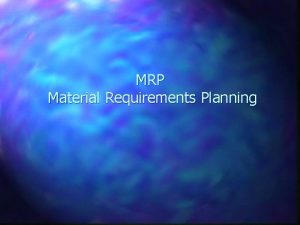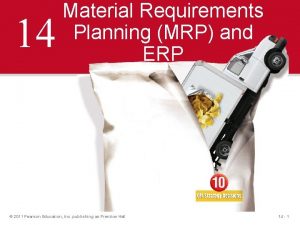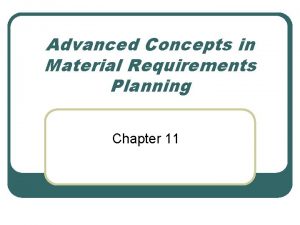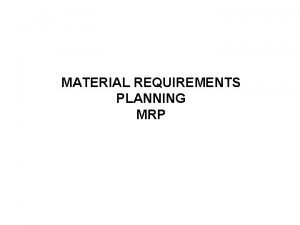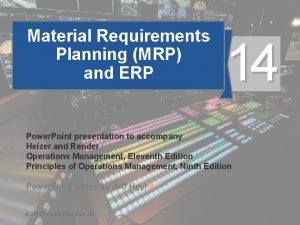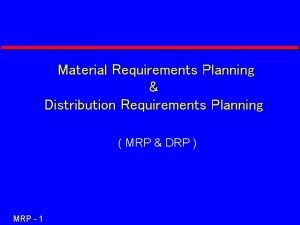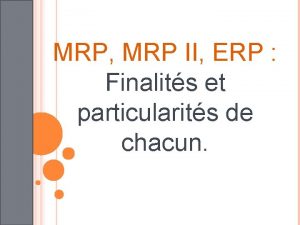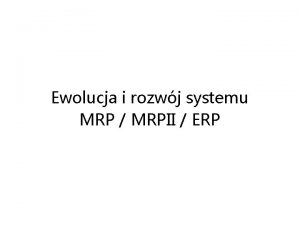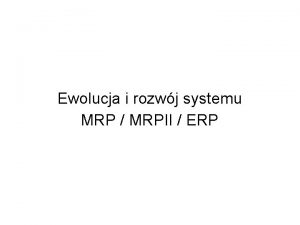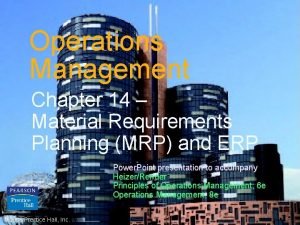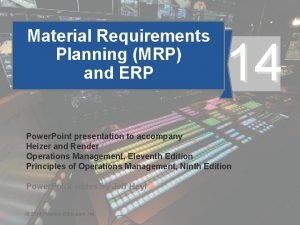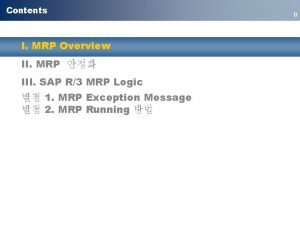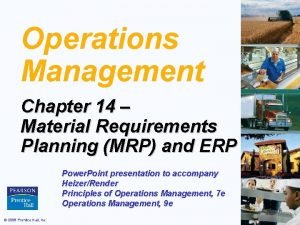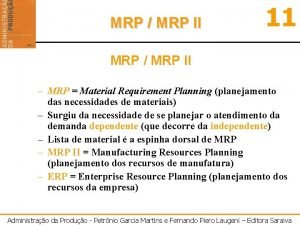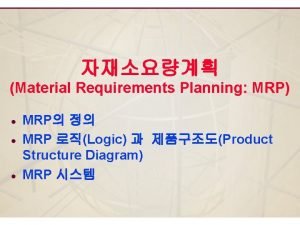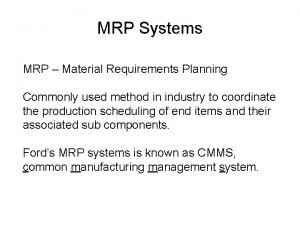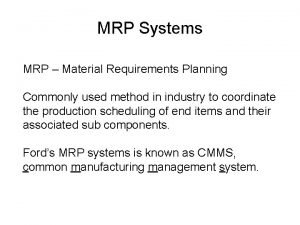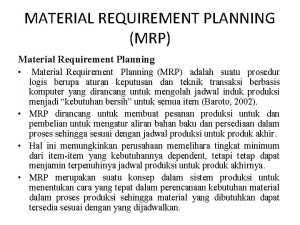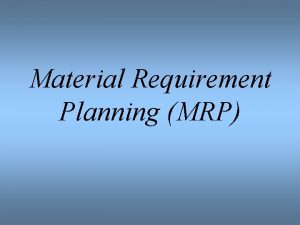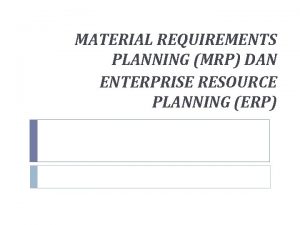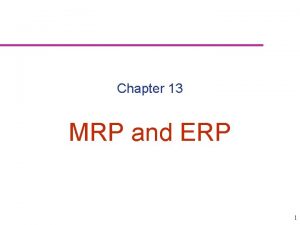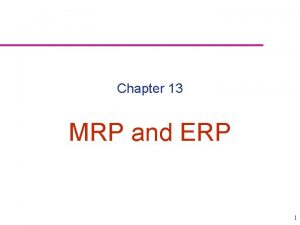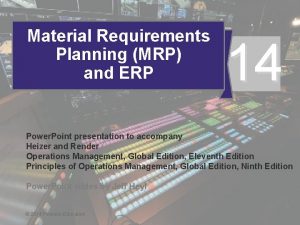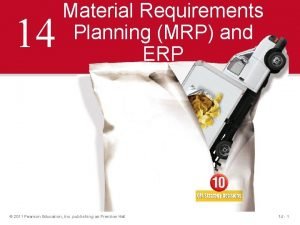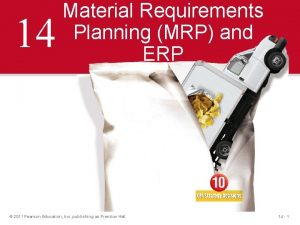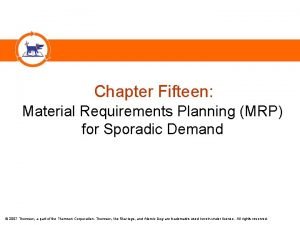MRP Material Requirements Planning MRP is a planning




















- Slides: 20

MRP Material Requirements Planning

MRP • …is a planning and scheduling technique used for batch production of assembled items. • … is a computer-based information system that translates master schedule requirements for end items into time-phased requirements for subassemblies, components, and raw materials. • It… – enables low levels of in-process inventories – helps to track material requirements – helps to evaluate capacity requirements – is a means of allocating production time

Independent and dependent demand • A demand is independent if it is needed for its own. The demand of end-products are usually independent. • Dependent demand is a demand for items that are subassemblies or component parts to be used in production of finished goods. • Once the independent demand is known, the dependent demand can be determined.

Stable demand Demand Comparison of independent and dependent demand Time Amount on hand Time “Lumpy” demand Safety stock Time

Independent Demand Dependent Demand A C(2) B(4) D(2) E(1) D(3) F(2) Independent demand is uncertain. Dependent demand is certain.

MRP • Based on the master schedule, it is • working backward from the due date using lead times and other information, • to determine when and how much to order from materials, components, subassemblies etc. • So that ordering, fabrication, and assembly can be scheduled for timely completition of end items while inventory leveles are kept low.

Overview of MRP Inputs MRP Processing MRP Outputs Changes Order releases Master schedule Planned-order schedules Primary reports Bill of materials Inventory records MRP computer programs Secondary reports Exception reports Planning reports Performancecontrol reports Inventory transaction

Inputs of MRP • Master production schedule: states which end products are to be produced, when and in what quantities. Inputs of the master schedule are customer orders and forcasts. Separates the planning horizonts into time buckets. It should cover the cumulative lead time. • Bill-of-Materials (BOM): a listing of all of the raw materials, parts, subassemblies, and assemblies needed to produce one unit of a product. It is hierarchical and shows the quantities, too (assembly diagram, product structure tree, low level coding). • Inventory records: Includes information on the status of each item by time period (Gross requirements, scheduled receipts, amount on hand, lead times, lot sizes, etc. )

Processing MRP (assembly time chart) Procurement of raw material D Fabrication of part E Subassembly A Procurement of raw material F Procurement of part C Final assembly and inspection Procurement of part H Fabrication of part G Procurement of raw material I 1 2 3 Subassembly B 4 5 6 7 8 9 10 11

MPR Processing 2 • Gross requirements – Total expected demand • Scheduled receipts – Open orders scheduled to arrive • Planned on hand – Expected inventory on hand at the beginning of each time period

MPR Processing 3 • Net requirements – Actual amount needed in each time period • Planned-order receipts – Quantity expected to received at the beginning of the period – Offset by lead time • Planned-order releases – Planned amount to order in each time period

Updating the System • Regenerative system – Updates MRP records periodically • Net-change system – Updates MPR records continuously

MRP Outputs • Planned orders - schedule indicating the amount and timing of future orders. • Order releases - authorization for the execution of planned orders. • Changes - revisions of due dates or order quantities, or cancellations of orders.

MRP Secondary Reports • Performance-control reports: evaluate system operation • Planning reports: help to forecast future inventory requirements, e. g. purchase commitments • Exception reports: call attention to major discrepancies

Other Considerations • Safety Stock • Lot sizing – – – Lot-for-lot ordering Economic order quantity Fixed-period ordering

MRP is services • Services also need material components like packages, tools, physical environment or materials used in the services.

MRP II • Expanded MRP with emphasis placed on integration – Financial planning – Marketing – Engineering – Purchasing – Manufacturing

MRP II Market Demand Finance Manufacturing Master production schedule Marketing Production plan MRP Rough-cut capacity planning Capacity planning Adjust production plan Yes Problems? No Requirements schedules No Problems? Adjust master schedule Figure 13. 14 Yes

Enterprise resource planning (ERP) – Next step in an evolution that began with MPR and evolved into MRPII – Integration of financial, manufacturing, and human resources on a single computer system.

Thanks for the attention!
 Material requirements planning
Material requirements planning Lot sizing techniques in mrp
Lot sizing techniques in mrp Material requirements planning concepts
Material requirements planning concepts Net requirements mrp
Net requirements mrp Closed loop mrp system
Closed loop mrp system Drp and mrp
Drp and mrp Mrp mrp ii erp
Mrp mrp ii erp Mrp mrp 2 erp
Mrp mrp 2 erp Closed loop mrp
Closed loop mrp The gross material requirements plan combines
The gross material requirements plan combines Auxiliary dental materials
Auxiliary dental materials Gross material requirements plan
Gross material requirements plan Gd and t symbols
Gd and t symbols Rsq formula in standard costing
Rsq formula in standard costing What is cultural relativism
What is cultural relativism What is real culture
What is real culture Example of material culture
Example of material culture Material that are useful and harmful
Material that are useful and harmful Sap rounding value
Sap rounding value Wedding planning requirements
Wedding planning requirements Mrp is generally practiced on items with dependent demand.
Mrp is generally practiced on items with dependent demand.
